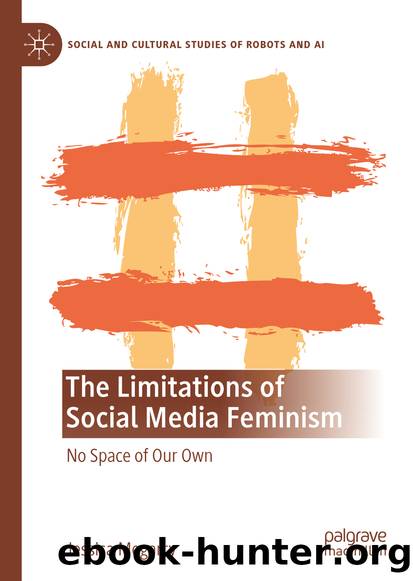The Limitations of Social Media Feminism by Jessica Megarry

Author:Jessica Megarry
Language: eng
Format: epub
ISBN: 9783030606299
Publisher: Springer International Publishing
Meghan Murphy (DN, CA) also felt that women self-censor when discussing transgender issues:I think that some women live in fear, itâs like âoh if I donât go along with this then [the transgender lobby are] going to turn on meâ because theyâve seen them do that to everyone else and because they probably will, cause thatâs how they control the conversation [â¦] people are scared of that, people are scared of being isolated, people are scared of being attacked.
Alongside concerns for their personal safety, interviewees also feared grave implications for their livelihoods if they were to publicly critique transgender ideology on social media. Academic Finn Mackay (DN, UK), for example, said: âI cannot afford to say something off the cuff that could be construed as transphobic and then never get invited to a conferenceâ.
While transgender rights activists have used social media to successfully create a cultural and political climate in which women are scared to express dissent, feminists, conversely, have struggled to advance their own critical analysis of gender identity politics in digital space. This is perhaps unsurprising: transgenderism is ideologically aligned with the commercial interests of social media companies in that it provides a hospitable base for the pornified consumer culture of transgenderism. As Sheila Jeffreys (2014, 186) has explained, transgender-identified individuals have used social media as a space of âempowered consumerismâ. The transgender community uses social media to trade tips on beauty practices, to share advice pertaining to the best products to buy to enact both social (i.e., breast binding and penis tucking) and medical (i.e., puberty blockers and hormonal therapies) transitions, and to create and share pedagogical YouTube videos and Tumblr posts detailing the process of transition (Cannon et al. 2017, 76; Evans et al. 2017, 134; Haimson et al. 2019). Transgender-identified men also post videos of individual transition timetables that clearly lay out the steps involved in both superficially and surgically altering oneâs appearance and body. These videos are often graphic in their depiction of medical interventions. Many promote an objectified and highly pornographic vision of womanhood (Jeffreys 2016).
Social media has also provided a hospitable base for the recruitment of actual numbers of transgender-identified individuals. On digital forums hosted by groups such as 4thWaveNow, parents have âdescribe[d] a process of immersion in social media, such as âbinge-watchingâ Youtube transition videos and excessive use of Tumblr, immediately preceding their child becoming gender dysphoricâ (Littman 2018; see also Brunskell-Evans and Moore 2018). In relation to the growing number of young women transitioning to men, journalist Jo Bartosch (2018, n.p.) has reported that:A Tumblr-inspired trend, [transgenderism] is tearing apart the youth lesbian community. Researchers estimate that 95â100 percent of the girls who identify as boys would otherwise grow up to be lesbian. [â¦] Many are turning online to make sense of their feelings, and a dearth of information about female same-sex attraction is leading girls to conceptualise their discomfort in their growing bodies as evidence of being transgender.
Download
This site does not store any files on its server. We only index and link to content provided by other sites. Please contact the content providers to delete copyright contents if any and email us, we'll remove relevant links or contents immediately.
Cecilia; Or, Memoirs of an Heiress — Volume 1 by Fanny Burney(31322)
Cecilia; Or, Memoirs of an Heiress — Volume 3 by Fanny Burney(30928)
Cecilia; Or, Memoirs of an Heiress — Volume 2 by Fanny Burney(30885)
The Great Music City by Andrea Baker(21195)
We're Going to Need More Wine by Gabrielle Union(18064)
Bombshells: Glamour Girls of a Lifetime by Sullivan Steve(13100)
Pimp by Iceberg Slim(12922)
All the Missing Girls by Megan Miranda(12739)
Fifty Shades Freed by E L James(12443)
Norse Mythology by Gaiman Neil(11873)
Talking to Strangers by Malcolm Gladwell(11861)
Crazy Rich Asians by Kevin Kwan(8340)
Mindhunter: Inside the FBI's Elite Serial Crime Unit by John E. Douglas & Mark Olshaker(7827)
The Lost Art of Listening by Michael P. Nichols(6462)
Enlightenment Now: The Case for Reason, Science, Humanism, and Progress by Steven Pinker(6403)
Bad Blood by John Carreyrou(5761)
The Four Agreements by Don Miguel Ruiz(5502)
Weapons of Math Destruction by Cathy O'Neil(5029)
We Need to Talk by Celeste Headlee(4861)
